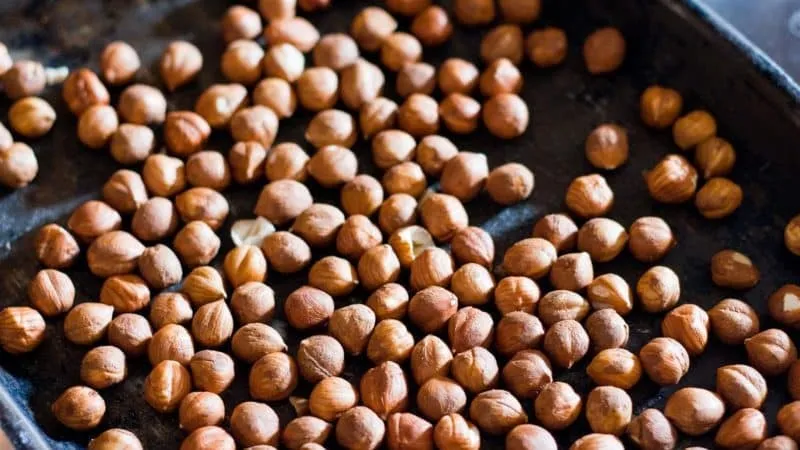Hazelnuts are rich in iron, B and E vitamins, and healthy fatty acids. They can be eaten whole, used in hot dishes and desserts, or applied in traditional medicine. However, proper preparation is essential before consumption.
Hazelnuts are best used in their dried form. Removing excess moisture enhances their flavor and aroma, making them crisp and eliminating bitterness. It also reduces the risk of spoilage during storage. Learn how to dry hazelnuts—both in-shell and shelled—using various home methods below.
Table of contents
How to Dry Hazelnuts – In-Shell or Shelled

Hazelnuts can be dried either in-shell or shelled. Many wonder which method is better.
In-shell nuts last longer, as they are protected from harmful microorganisms and oxidation. There’s no need to shell them before drying—simply crack them open when needed.
Shelled nuts are more convenient for immediate use. While shelling them all at once takes effort, it saves time later. Shelled nuts also make it easier to spot and discard spoiled ones.
Drying shelled nuts is faster than in-shell. However, not all drying methods work for in-shell hazelnuts.
Did you know? Wild hazelnuts (Corylus avellana) and cultivated hazelnuts (Corylus maxima) share the same taste and nutritional profile. Wild hazelnuts are smaller and oval, while cultivated ones are larger and rounder. Wild hazelnuts grow in forests, whereas cultivated varieties are farmed.
Harvesting and Preparing Hazelnuts
Before drying, hazelnuts must be properly harvested and prepared. The harvest season is September. Ripe nuts have a reddish-brown or light brown hue. Green ones are unripe and need time to mature.
To harvest hazelnuts, spread a light cloth or plastic sheet under the bush. Shake the plant gently to make the nuts fall onto the sheet.
Sort the harvested nuts, removing stems and any with mold, dark spots, or holes—signs of spoilage or insect infestation.
If drying in-shell, rinse them in a bowl of water, then pat dry with a towel.
To shell raw hazelnuts, soak them in boiling water for an hour. Then, crack the shells with a nutcracker or small hammer.
Inspect the kernels, discarding any discolored, moldy, or foul-smelling ones.
To remove the thin skin, blanch the kernels in boiling water for 5 minutes. The skin will peel off easily with fingers or a cloth.
Note: Some prefer removing the skin after drying. However, this risks burning the delicate membrane during the drying process.
Methods for Drying Hazelnuts at Home
Several techniques exist, from specialized equipment to simple air-drying. Each has its pros, cons, and steps.
Oven Drying
Ovens are a common household appliance, making this method accessible. Both electric and gas ovens work well for shelled or in-shell nuts.
Drying shelled hazelnuts:
- Line a baking tray with parchment paper. Spread kernels in 1-2 layers.
- Preheat the oven to 60-100°C. Use convection mode if available, or leave the door slightly ajar.
- Stir occasionally and check for doneness.
Drying takes 1-2 hours, depending on temperature. Higher heat speeds up the process but reduces nutrient retention.
Drying in-shell hazelnuts:
- Spread nuts on a tray in 1-2 layers (no parchment needed).
- Preheat the oven to 120°C.
- Stir occasionally during drying.
In-shell drying takes 4-6 hours. Test by cracking a nut to check the kernel.
Tip: Well-dried kernels are golden inside and out, with a rich aroma. Cooled nuts should be crisp.
Quick oven method (for both shelled and in-shell):
- Spread nuts on a parchment-lined tray. Preheat oven to 180°C.
- Stir every 5 minutes until done.
- Shelled nuts take ~10 minutes; in-shell nuts take 20-30 minutes.
Another method: Preheat oven to 180°C, add nuts in a single layer, then turn off the heat. Leave until cooled.
Microwave Drying
Microwaving is the fastest method, taking under 10 minutes. Techniques differ for shelled vs. in-shell nuts.
Shelled hazelnuts:
- Arrange kernels in a single layer on a microwave-safe plate.
- Microwave at 750W for 3 minutes.
- Flip nuts, leave the door open to cool, then repeat.
- Check doneness. If needed, cool and microwave for 2 more minutes.
In-shell hazelnuts:
- Arrange nuts in a single layer.
- Microwave at 750W for 10 minutes.
- Cool, then check a kernel. If underdone, microwave 5 more minutes.
Limitation: Only ~300g fits at a time.
Pan Roasting
Pan roasting is quick (3-10 minutes) and yields golden-brown kernels. However, high heat degrades some nutrients, and over-roasting is a risk.
In-shell roasting:
- Heat a dry pan over low heat. Add nuts, roast 3-4 minutes.
- Increase heat to high, roast 5-7 more minutes, stirring constantly.
Shelled roasting:
- Roast on low heat, stirring continuously until fragrant and lightly golden.
- Transfer immediately to a cool plate to prevent burning.
Note: Use thick-bottomed pans to avoid scorching.
Using a Food Dehydrator
Dehydrators take longer but ensure even drying and nutrient preservation.
Steps:
- Spread nuts on dehydrator trays in single layers.
- Set to 90°C for 4 hours (no stirring needed).
- Cool and check. If underdone, restart.
Shelled nuts take 4-6 hours; in-shell nuts may take up to 24 hours.
Air-Drying Outdoors
Natural drying preserves nutrients best, though kernels remain pale (not golden). Best for in-shell nuts to avoid pests.
Steps:
- Spread nuts on trays or cloth, cover with cheesecloth.
- Place in a sunny, breezy spot. Stir several times daily.
- Bring indoors at night and during rain.
Drying takes ~1 week in good weather. Indoors, place near a radiator or heated floor.
Storage After Drying
To keep dried hazelnuts fresh and safe:
- Use breathable containers (cloth bags or glass jars). Avoid plastic bags to prevent condensation.
- Store in a cool, dark, dry place.
- Keep separate from other nuts to preserve flavor.
- Avoid strong-smelling items nearby.
- Discard moldy or foul-smelling nuts—they may be toxic.
- Store up to 6 months (3 months for high-heat roasted nuts).
Conclusion
Drying hazelnuts enhances flavor, removes bitterness, and extends shelf life. Methods range from minutes (microwave) to weeks (air-drying). Lower temperatures preserve more nutrients and prolong storage.







